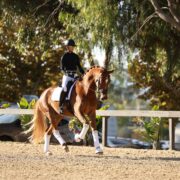Liverpool Fears Be Gone: How To Train Your Horse To Jump Water Properly

The dreaded liverpool.
A liverpool is a water-type jump where a small (sometimes inflatable, sometimes made out of tarp-like material) circular or square pool of water is placed on the ground usually underneath rails of a jump. There are few other fences that draw as much spook out of a horse than the shallow waters of a liverpool in a show jumping course. But never fear – Heels Down Mag has some tips to help instill confidence in your horse as he learns to jump a liverpool fence without issue.
Understand What Makes It Scary
Obviously there’s more to a liverpool fence than a jump with a some flowers, fern bushes, or other decorations at the base or along the outer sides. There’s actual water. Though it may be shallow, water is clearly moving in that small pool, and its ability to reflect light is enough to cause even the bravest of green horses to second-guess going over it.
Before you start asking your horse to haul himself and you safely over it, it’s important to recognize the factors that make this jump so scary. You’ll want to eliminate as many of those as you can to make the first few attempts as comfortable and confidence boosting as possible. This should be a given, but your horse should already be schooling other types of fences without issue, including cross rails, oxers, verticals with flower boxes and even roll tops, before attempting the liverpool for the first time.
Modify To Make It Less Scary
Remember, confidence building is key. So let’s make the liverpool the least intimidating it can be for the first few attempts. We recommend placing two broad jump standards (preferably the winged standard types) at the edge of the pool. You’ll want the pool to be empty for this first attempt. You should fold your liverpool in half (if possible) to make it less wide. Use actual rails from the fence and lean them against the standards to create a wide chute leading up to the liverpool.
Ride With Purpose, But Be Kind
Just like in any other green moments with your horse, when it’s time to attempt to jump the liverpool for the first time, it’s important that you are riding with authority and confidence. We recommend trotting the modified liverpool first (unless you are more comfortable and able to control the canter). Keep your leg and seat activated as you approach the jump, and keep a light contact on your horse’s mouth. Be prepared if his gait stutters or even if he stops. He might stop, and that’s OK.
It’s important to remember not to reward your horse for stopping though. Do not pet him to make him feel better. Instead, get his attention focused back on the job at hand, and ask him to go over the jump again. The goal here is to encourage him to get to the other side, even if it isn’t pretty the first time (or first couple of times). Some trainers recommend jumping the liverpool going toward “home” (i.e., the barn or the in-gate) to further encourage the horse to go forward over the jump.
Build It Out
Once your horse is jumping the modified liverpool comfortably at the trot and canter, you can begin to undo all the modifications you made to the jump. First, unfold the liverpool and let it lie on the ground in its full size. Jump the liverpool as is with your rails still leaning against the standards. Once you’ve mastered that, remove the poles from leaning on the standards. Then it’s time to add water. Use the same confident eye, seat, leg and hand to encourage your horse to go over the fence just as he’s done successfully in earlier iterations. You want him to be proud of himself! Once he’s jumping the liverpool with water without issue, it’s time to add rails to the actual fence and increase the height slowly.
What’s Next?
Some trainers will add food coloring to sharpen the color of the water in the liverpool, which is a great desensitizing exercise. It’s important that you continue to jump the liverpool confidently over the span of several weeks to instill confidence and training in your horse. The exercises above could be done in just one day or one schooling round, or it could be done over several days or weeks, depending on your level of riding ability and how green the horse is you’re working with.


